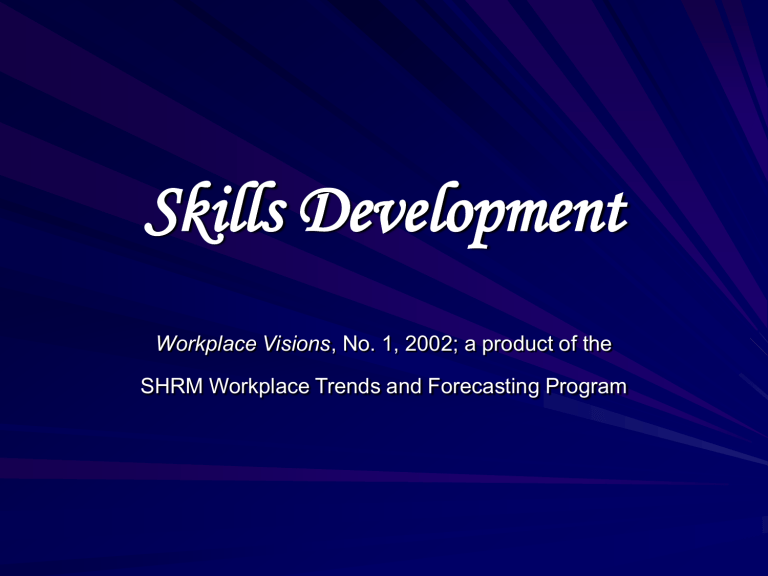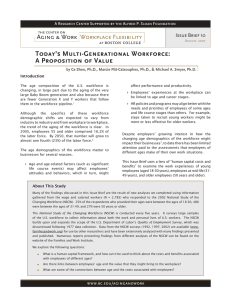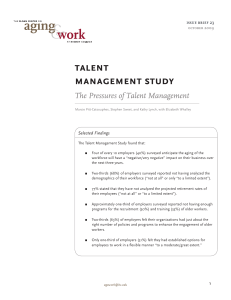Skills Development - Indiana University

Skills Development
Workplace Visions , No. 1, 2002; a product of the
SHRM Workplace Trends and Forecasting Program
What will it take to complete?
According to the U.S. Bureau of Labor Statistics, employment in occupations requiring at least a bachelor’s degree is expected to grow
21.6 percent. And all but two of the 50 highest paying occupations require a college degree.
New jobs increasingly require both general and occupationspecific skills, are more demanding, involve more teamwork and worker participation, and are in occupations that allow people to think and be creative on the job. The BLS predicts that jobs in the services sector will account for 20.2 million of the 22.0 million new wage and salary jobs generated over the 2000-10 period, with much of that growth coming in hospitality and health care service jobs requiring only on-thejob training. But at the same time, jobs in professional, technical, and managerial occupations rose from 1 in 6 workers in 1950 to about 1 in
3 in 1995. Census studies also indicate that over the most recent U.S. business cycle (1989-1995), 75 percent of the 7 million new jobs were in professional specialties or managerial occupations.
To assess what sorts of skills may be necessary to compete in the information economy, The League for the Innovation of Community
Colleges, in partnership with the Pew Charitable Trusts produced a report in 2000 entitled Learning Outcomes for the 21st Century: Report of a Community College Study.
This project identified eight clusters of critical life skills needed for students to survive and flourish in the digital age:
5.
6.
7.
1.
2.
3.
4.
8.
Technology skills —acquiring computer literacy and Internet skills, retrieving and managing information via technology.
Communication skills —reading, writing, speaking, listening.
Computation skills —understanding and applying mathematical concepts and reasoning, analyzing and using numerical data.
Critical thinking and problem solving —evaluating, analyzing, synthesizing, decision making, creative thinking.
Information management skills —collecting, analyzing, and organizing information from a variety of sources.
Interpersonal skills —developing teamwork, relationship management, conflict resolution, and workplace skills.
Personal skills —understanding self, managing change, learning to learn, taking personal responsibility, understanding, aesthetic responsiveness, and wellness.
Community skills —building ethical, citizenship, diversity/pluralism, and local, community, global, and environmental awareness.
Certainly the attributes listed in the Learning Outcomes report, as well as the data regarding growth in occupations over the next ten years points to the need for technology, critical thinking, and social awareness skills beyond that provided by a high school education and minimal on-the-job training. And even for the so-called blue-collar jobs, reliance on technology, and an increasing diversity of customer base may necessitate training in specific skills in proprietary or open source technology, critical thinking, and interpersonal skills.
Where do we stand now?
According to the U.S. Department of Education, about 84 percent of all
U.S. adults age 25 and over have high school diplomas and 26 percent have bachelor’s degrees. And according to a study conducted by the
Organization for Economic Cooperation and Development (OECD), 40 percent of the U.S. adult population lacks the literacy skills required to participate in today’s complex knowledge economy. Changing demographics, with an aging population and increasing ethnic diversity, may also contribute to a rising skills gap in the workforce.
Further, disparities in the education levels and income of
Americans are increasingly drawn along lines of ethnicity and race, with
Hispanics and blacks on the lower end and non-Hispanic whites and
Asians on the upper end. As the economy shifts to one where knowledge and facility with technology take precedence over physical skills, education levels will take on added significance. And without a concerted effort to raise education levels for groups on the lower end of the scale, their place on the socioeconomic ladder may become a selffulfilling prophecy.
Another significant population that may be affected by the increasing reliance on technology is the elderly. Approximately 13 percent of the population is age 65 and older. By 2030, 20 percent of
Americans, about 70 million, will be over 65. And these older people want to work.
How do we close the gap?
The shift in the American and global economy mean that those who lack education beyond high school or do not possess specific technology skills will find their opportunities and economic mobility severely restricted. Our service-based economy requires a level of knowledge and skill that, for the most part, can be gained only through programs offered beyond high schools. Demographic changes will also necessitate rethinking the structure of the education system, and looking towards adult education, corporate training and development, and the role of technology in easing some of the skills gaps that may develop.
Education Reform
The recently signed education bill signals a federal commitment towards education reform. And though the federal government spends only seven cents of every dollar spent on education, it provides an important national vision for education reforms. As a global economy requires a highly skilled national workforce, the federal government’s role in pushing for reform may increase substantially.
Current educational reforms, targeted mainly at elementary and secondary education, are driven by public concern about the quality of the U.S. educational system and its ability to produce workers with the high skills needed to compete in the global economy.
Seven Ideas that Work
1.
2.
3.
4.
5.
6.
7.
Pay Teachers for Performance
Make Schools Smaller
Hold Educators Accountable
Offer More Variety
Provide Adequate Funding
Increase Time in School
Use Technology
Source: Business Week
Though no single idea can solve the many ills of America’s schools, suggestions such as those provided by Business Week magazine (see box “Seven Ideas that Work”) may represent a good beginning. Human resource professionals understand especially well that paying teachers better may go a long way towards improving education quality. According to the U.S. Labor Department, U.S. schools may need to fill 2.2 million teaching vacancies over the next decade. Competitive salaries, flexible compensation systems, and more training will be critical in attracting a new generation to the teaching profession.
Corporate Training and
Development
The increasingly transitory nature of work is underscored by a
Department of Labor study revealing that new entrants into the workforce can expect to work for an average of eight different employers in their working lives. This continual turnover, together with an increasing reliance on technology and an aging population may increase the focus on corporate training and development programs.
The growing skills gap is best summed up by a Hudson
Institute finding that 60 percent of jobs will require skills that only 20 percent of the workforce currently possesses. Education reform in the nation’s primary, secondary, and higher education systems is one way to tackle this problem. But rapid changes in a technology reliant economy and the increasing transitory nature of the workplace mean that corporate training and development programs will also play a big role in skills development.
Adult enrollments in higher education institutions are expected to increase to 50 percent of total postsecondary enrollments by 2010, according to the National Association of College Admissions
Counseling. Continuing education does not necessarily mean just the pursuit of more formal degrees. Individual courses, certificates, and professional certification programs lasting anywhere from a few days to a few months are available through a myriad of public and private institutions, and increasingly available on the Internet.
Corporate training and development programs may also increase partnerships with non-profit or for-profit educational institutions to tailor courses or entire programs for specific skills or proprietary knowledge. Many large companies such as Oracle and Andersen already provide an institutionalized framework of study for their employees. These corporate universities include everything from highly technical courses to courses representing a broad overview of general business skills, and have gained a huge amount of attention in the past ten years.
In a market economy, with lots of attention paid to the bottom line, all this focus on training needs some sort of payoff. And training investments pay off, according to a new study conducted by the
American Society for Training and Development. The ASTD study found that companies who invested $680 more in training per employee than the average company in the study improved their total stock return the next year by six percentage points.
Fortunately, 93 percent of employers provide professional development opportunities for their employees, and 73 percent provide educational assistance, according to the 2001 Benefits Survey , conducted by the Society for Human Resource Management. But the
SHRM survey also points out that educational assistance benefits have been steadily declining over the past five years, and also vary greatly between industries.
Also, merely making available certain benefits does not necessarily mean that they will be used. Human resource professionals may have to be proactive in encouraging employees to increase their skills and knowledge as a way to increase employee and company competitiveness.
The Role of Technology
While technology may act as a dividing force when it comes to access to jobs, technology may also level the field regarding access to information and training. Technology-enabled education, in the form of degree-awarding programs or specific courses, may greatly enhance the opportunities available to workers seeking skills improvement.
It took the automobile 55 years to reach “mass use” in the U.S., defined as 25 percent of the total population using an innovation. In contrast, it took the Internet only 4 years to reach the same penetration level. By now, we all know how indispensable the Internet has become.
And as more people go online to conduct day-to-day activities such as business transactions, personal correspondence, research and shopping, being digitally connected becomes ever more critical to economic, educational and social advancement. Technology, specifically the Internet, may also play a big role in skills development as training becomes more available through the Internet.
Data from various sources point to the huge and growing potential of technology in training and development. According to researchers at International Data Corporation (IDC), 2.2 million students are expected to enroll in on-line learning courses by 2002, up from 710,000 in 1998. The number of distance learning students is increasing at a rate of 33 percent per year —by 2002, the number of distance learning students will reach 2.23 million, according to the
Nontraditional Students Report .
The move to online learning is helped by changing demographics and a more transitory nature of employment. The U.S.
Department of Education reports that nearly 50 percent of today’s rising post-secondary enrollment are adults age 25 years or older. This rise in adult education is due mostly to the rise in multiple careers. And almost all of these adult students are trying to balance full-time employment with further education, creating a tremendous impetus for a technologyenabled training market.
The role of technology is not just limited to degree-granting institutions. Employers are beginning to invest heavily in training programs that can be accessed and completed at employee workstations. And though not all types of training can be effectively completed through a computer, and initial costs for the technology may be high, the long-term return for employers is driving the move towards this type of training programs.
A cautionary note to this development is the lack of research to determine if technology-based education will do the trick in reducing the skills gap.
Conclusion
The quality of the labor pool is dependent on its knowledge and skills, and in an economy where change occurs with amazing rapidity, skills development is increasingly a continual process. Employers have a compelling interest in the health of the education system, and in training and development programs for their employees to ensure an adequately educated workforce.
Education reform efforts must look forward and take into account demographic changes and technology opportunities to fashion a system that can ensure a quality education for all Americans.
Workforce diversity is being driven by immigration and an aging population. Immigrants with different language skills and educational and cultural backgrounds may need different education and training mechanisms.
So too with the aging population. There may be a need to adapt to a new style of work as seniors choose to work part-time, or work as contractors. They may also need to be trained in new technologies and relearn the cultural skills of working in an information economy.
Corporate involvement in training and development must also look at long-term pay-offs rather than immediate costs. And the role of technology must be evaluated for use in public education and workforce training.
Human resource professionals charged with staffing a productive workforce are already involved with corporate training and development programs. They may also need to become involved in pushing greater reform and accountability measures in their local educational systems.











